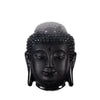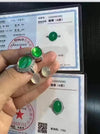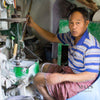Background
We are frequently contacted by our customers and the general public wanting to verify if the green stone, bangle, jade jewellery or carving they have is genuine jade. Often, their first justification for their stone being genuine is that it's cold to the touch and it's green in colour. This is understandable, as there are countless articles and guides on the internet stating that one way to determine if jade is real is by feeling for its coldness. Hence, we decided to conduct this experiment to see if it's possible for someone to differentiate real jade from fakes just by feeling for the coldness.
Is Real Jade Cold to the Touch?
The simple answer to this question is yes, but can one use this physical property of jadeite to tell it apart from other stones; be it fake jade or treated jade? The science behind why jade is cold to the touch is based on its thermal conductivity. Thermal conductivity describes how well a mineral can transfer or conduct heat and is intrinsic to the mineral's structure and composition, varying widely among different minerals. In the context of our experiment, we are going to find out if the difference in thermal conductivity between real jade and its imitations would play a key role in their identification.

The Jade Coldness Experiment
We designed this experiment to see if any layperson (such as those who would follow the "How to Tell if Jade is Real'' guides on the internet) can actually tell which is real jade from a tray of 6 samples. Only one sample is real jade and the other 5 are a mix of jade imitations and treated jade. Participants were blindfolded in the first part of the experiment to eliminate visual cues and asked to feel each sample to determine its authenticity based on perceived coldness alone. The second part of the experiment allows the participants to remove their blindfold and include visual cues along with touching the samples. The study involved a total of 15 participants selected at random in public. Some of the participants acknowledged their familiarity of jade’s properties or appearance while the majority of the participants denied having any prior experience or specific knowledge about jade.
Participants
The 15 participants were passersby in a public area invited by us at random to take part in the experiment and were given a small gift for their participation. They were further incentivised with a $100 giftcard to pick what they felt was the coldest or real jade sample.

Samples
6 samples were used in the experiment to reduce the likelihood of participants guessing correctly by chance and to ensure that any correct identification is more likely due to genuine tactile differentiation. The samples were: a synthetic glass bangle, a dyed and polymer impregnated jade bangle, a genuine jadeite jade bangle, a quartzite (Guizhou Jade) bangle, an agate bangle, and a polymer impregnated jade bangle. Click here to learn more about jade treatments and jadeite grades or types.
| Sample | Material | Thermal Conductivity (W/m·K) |
|---|---|---|
| 1 | Glass | 0.8 - 1.2 |
| 2 | B+C Jade | 1.85 - 2.6 |
| 3 | Natural Jadeite | 2.1 - 6.6 |
| 4 | Quartzite | 2.6 - 5.4 |
| 5 | Agate | 0.4 - 0.6 |
| 6 | B Jade | 1.85 - 2.6 |
Testing Method
The sample bangles were numbered from 1 to 6 with paper tags and placed on a tray. The tray was then covered with a piece of cardboard to prevent any visual cues while we invited the participants. When a passerby agreed to participate in the experiment, we explained the purpose of the experiment and asked if they had any prior knowledge of jade. Each participant was given a blindfold for the first part of the touch-only experiment. Each sample was then touched to their cheeks. After touching all the samples, participants were asked to identify which one they believed was the real jade. For the second part of the experiment, participants removed their blindfolds and were asked to identify the real jade sample again by both seeing and feeling the coldness. Responses were recorded, along with any additional comments participants provided regarding their decision-making process.
Results
In the blindfolded test, only 1 participant (6.7%) correctly identified the genuine jade sample, while 40% each misidentified the dyed and polymer impregnated jade and quartzite samples which indicates that these materials closely mimic the tactile properties of real jade. In the visual and touch test, the correct identification rate increased to 40%, showing that visual cues significantly enhance the ability to identify real jade. However, the increased accuracy in positive identification is likely due to some participants' familiarity with the appearance of real jade because test samples were purposefully biassed in a way where the fake jade samples are visually very obvious to distinguish. Nonetheless, 33.3% of participants still misidentified the quartzite bangle, and 20% chose the polymer impregnated jade, suggesting these materials have strong visual similarities to real jade. The results highlight the difficulty laypersons face in authenticating jade through touch alone.

Blindfolded Test:
- Sample 1 (Glass): Not chosen by any participant.
- Sample 2 (B+C Jade): Chosen by 40% of participants.
- Sample 3 (Natural Jadeite): Chosen by 6.7% of participants.
- Sample 4 (Quartzite): Chosen by 40% of participants.
- Sample 5 (Agate): Chosen by 6.7% of participants.
- Sample 6 (B Jade): Chosen by 6.7% of participants.

Visual and Touch Test:
- Sample 1 (Glass): Not chosen by any participant.
- Sample 2 (B+C Jade): Not chosen by any participant.
- Sample 3 (Natural Jadeite): Chosen by 40% of participants.
- Sample 4 (Quartzite): Chosen by 33.3% of participants.
- Sample 5 (Agate): Chosen by 6.7% of participants.
- Sample 6 (B Jade): Chosen by 20% of participants.
Analysis
The results of the blindfolded test are consistent with the scientific explanation behind why jade feels cold to the touch; its thermal conductivity property. Among the 6 samples tested, Agate and Glass, which have significantly lower thermal conductivity compared to real jade, were correctly not chosen by participants. However, for the remaining samples which showed overlapping or similar thermal conductive properties, lead to incorrect identifications by participants. Overall results of both visual and tactile tests showed that Quartzite (Sample 4) was consistently misidentified as real jade. This confirms its resemblance to real jade in both thermal conductivity and appearance.

Sample 1: Glass
Glass is one of the most commonly used imitation materials for natural gemstones. While this specific sample may be easily discernible to a professional or a jade enthusiast, there are glass bangles with less obvious colouring on the market that are not as easy to visually distinguish from real jade bangles. The thermal conductivity of common glass (such as soda-lime glass) is typically around 0.8 to 1.0 W/(m·K) at room temperature.

Sample 2: Type B+C Jade
Grade or Type B+C Jade is made from jadeite that has been bleached and then impregnated with dyed polymers. The extent of the polymer impregnation can vary, with some samples being visually indistinguishable from natural jadeite jade. The sample used in the experiment was purposefully selected for its discernible appearance. Due to its composite nature, the thermal conductivity of this sample is estimated to be between 1.85 and 2.6 W/m·K.

Sample 3: Natural Jadeite
This sample is a genuine jade bangle carved from natural jadeite stone from Burma (Myanmar). It is also the only bangle in the sample pool that is a round profile. The thermal conductivity of jadeite, a pyroxene mineral, is generally around 2.1 to 6.6 W/m·K. Because jadeite is polycrystalline, this value can vary depending on the specific composition and purity of the jadeite sample.

Sample 4: Green Quartzite
Quartzite, also known commercially as Guizhou Jade, is a type of metamorphosed sandstone that resembles jade. Hence, this imitation jade bangle often fool unsuspecting buyers, thinking it's a type of real jade. It may look similar but quartzite is not jade. The thermal conductivity of quartzite typically ranges from about 2.6 to 5.4 W/m·K.

Sample 5: Agate
Agate is a type of Chalcedony, a cryptocrystalline variety of quartz. One can visually identify this sample as agate from its characteristic banding pattern. Another variety from the Chalcedony family that has a similar resemblance to jade is Chrysoprase or Australian Jade. Generally, agate has a thermal conductivity in the range of 0.4 to 0.6 W/m·K.

Sample 6: Type B Jade
Grade or Type B Jade is also a polymer impregnated jadeite but there are no dyes added. In our opinion, this is the most dangerous type of fake jade in the market. They can be virtually undetectable even to the most professional eyes. This particular sample used in the experiment even comes with its own fake certification from China stating it’s Grade A Jade. Due to its composite nature, we estimate the thermal conductivity of this sample to be between 1.85 and 2.6 W/m·K.
Considerations and Biases
Several factors may have influenced the experiment's results:
- Outdoor Setting: The experiment took place outdoors, where variations in sample and ambient temperatures were beyond our control. This may have affected participants' perception of coldness.
- Surface Area and Shape: The samples varied in shape, affecting the surface area in contact with participants' skin. A larger contact surface might be perceived as colder, potentially influencing participants' judgments.
- Duration of Touch: The duration for which participants touched each sample was not standardised. Differences in touch duration may have impacted how cold each sample felt.
- Sample Size: While an ideal number of participants for statistical robustness is typically around 30, the experiment was limited to 15 participants conducted over two days due to time constraints.
- Participant Knowledge: The sole participant, who correctly identified sample 3 in the blindfolded test, may have had prior knowledge of which sample was real jade. She had observed the setup before participating which could have biassed the results.
- Sample Bias: Samples 1 and 2 were intentionally chosen to be visually distinguishable from real jade.
- Sample Appearance: Sample 3, the real jade bangle, was intentionally chosen for its round profile as compared to the rest of the samples which had halfmoon profiles. This was to visually distinguish the real jade sample for our video viewers to follow through the experiment.
- Thermal Conductivity: Actual thermal conductivity of the samples were not measured.
Conclusion
From the experiment's results, it is evident that identifying real jade based solely on its perceived coldness is unreliable. While it’s possible to distinguish real jade from Glass and Agate, which have significantly lower thermal conductivity, there are many other imitations and fake jade(treated jade) materials with overlapping thermal conductive properties which will likely lead to a misidentification.

WAI YAN











I am interested to replace my bangle. Does May have an email to assist me with a selection of jadeite half round
5-7mm wide , 18mm internal diameter.
I am more inclined to a mid green in color.
I prefer a high end grade.
Are real jade bracelets expensive?
look forward your reply